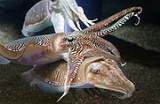
Cuttlefish
Overview
Cuttlefish are marine
animals of the order
Sepiida. They belong to the class
Cephalopod
a (which also includes squid
, octopus
es, and nautilus
es). Despite their name, cuttlefish are not fish but molluscs.
Cuttlefish have an internal shell
(the cuttlebone
), large W-shaped pupil
s, eight arm
s and two tentacle
s furnished with denticulated suckers, with which they secure their prey. They generally range in size from 15 cm (5.9 in) to 25 cm (9.8 in), with the largest species
, Sepia apama, reaching 50 cm (19.7 in) in mantle
length and over 10.5 kg (23.1 lb) in weight.
Cuttlefish eat small molluscs, crabs, shrimp, fish, octopuses, worms, and other cuttlefish.
Marine (ocean)
Marine is an umbrella term. As an adjective it is usually applicable to things relating to the sea or ocean, such as marine biology, marine ecology and marine geology...
animals of the order
Order (biology)
In scientific classification used in biology, the order is# a taxonomic rank used in the classification of organisms. Other well-known ranks are life, domain, kingdom, phylum, class, family, genus, and species, with order fitting in between class and family...
Sepiida. They belong to the class
Class (biology)
In biological classification, class is* a taxonomic rank. Other well-known ranks are life, domain, kingdom, phylum, order, family, genus, and species, with class fitting between phylum and order...
Cephalopod
Cephalopod
A cephalopod is any member of the molluscan class Cephalopoda . These exclusively marine animals are characterized by bilateral body symmetry, a prominent head, and a set of arms or tentacles modified from the primitive molluscan foot...
a (which also includes squid
Squid
Squid are cephalopods of the order Teuthida, which comprises around 300 species. Like all other cephalopods, squid have a distinct head, bilateral symmetry, a mantle, and arms. Squid, like cuttlefish, have eight arms arranged in pairs and two, usually longer, tentacles...
, octopus
Octopus
The octopus is a cephalopod mollusc of the order Octopoda. Octopuses have two eyes and four pairs of arms, and like other cephalopods they are bilaterally symmetric. An octopus has a hard beak, with its mouth at the center point of the arms...
es, and nautilus
Nautilus
Nautilus is the common name of marine creatures of cephalopod family Nautilidae, the sole extant family of the superfamily Nautilaceae and of its smaller but near equal suborder, Nautilina. It comprises six living species in two genera, the type of which is the genus Nautilus...
es). Despite their name, cuttlefish are not fish but molluscs.
Cuttlefish have an internal shell
Mollusc shell
The mollusc shell is typically a calcareous exoskeleton which encloses, supports and protects the soft parts of an animal in the phylum Mollusca, which includes snails, clams, tusk shells, and several other classes...
(the cuttlebone
Cuttlebone
Cuttlebone, also known as cuttlefish bone, is a hard, brittle internal structure found in all members of the family Sepiidae, commonly known as cuttlefish....
), large W-shaped pupil
Pupil
The pupil is a hole located in the center of the iris of the eye that allows light to enter the retina. It appears black because most of the light entering the pupil is absorbed by the tissues inside the eye. In humans the pupil is round, but other species, such as some cats, have slit pupils. In...
s, eight arm
Cephalopod arm
A cephalopod arm is distinct from a tentacle, though the terms are often used interchangeably.Generally, cephalopod arms have suckers along most of their length, as opposed to tentacles, which have suckers only near their ends. Octopuses have eight arms and no tentacles, while squid and cuttlefish...
s and two tentacle
Tentacle
A tentacle or bothrium is one of usually two or more elongated flexible organs present in animals, especially invertebrates. The term may also refer to the hairs of the leaves of some insectivorous plants. Usually, tentacles are used for feeding, feeling and grasping. Anatomically, they work like...
s furnished with denticulated suckers, with which they secure their prey. They generally range in size from 15 cm (5.9 in) to 25 cm (9.8 in), with the largest species
Cephalopod size
Size has been one of the most interesting aspects of cephalopod science to the general public. This article lists the largest cephalopods from various groups, sorted in order of mantle length, total length, weight, and shell diameter...
, Sepia apama, reaching 50 cm (19.7 in) in mantle
Mantle (mollusc)
The mantle is a significant part of the anatomy of molluscs: it is the dorsal body wall which covers the visceral mass and usually protrudes in the form of flaps well beyond the visceral mass itself.In many, but by no means all, species of molluscs, the epidermis of the mantle secretes...
length and over 10.5 kg (23.1 lb) in weight.
Cuttlefish eat small molluscs, crabs, shrimp, fish, octopuses, worms, and other cuttlefish.
Unanswered Questions

